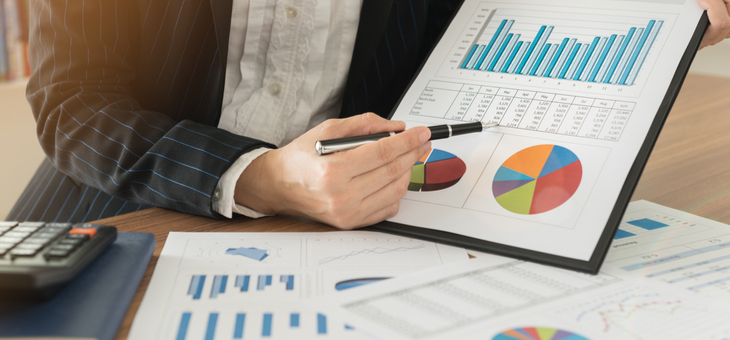The share market is a roller-coaster – up one day, down the next. As a result, ETFs, or exchange traded funds, have surged in popularity.
Since 2019, Australian monthly search traffic for the term ETF has tripledwith about 30,000 Australians searching every month in a bid to understand whether they, too, should invest in ETFs. And these researchers seem to be convinced by their research, because the amount of money invested in ETFs in Australia grew 79 per cent to more than $100 billion in the past year.
Online investment adviser Stockspot has just released its seventh annual report into the best and worst ETFs, but first, for anyone who is not familiar with ETFs, an explanation.
What are ETFs?
Essentially, if you liken a share to a basket filled with apples, an ETF is another basket filled with multiple types of fruit. You can buy one or more baskets filled only with apples, or you can buy one or more baskets filled with different types of fruit.
What that means is when you buy one ETF, you buy a small share of lots of different companies – sometimes hundreds of different companies. So instead of buying one share of Commonwealth Bank, one share of Woolworths and one share of Telstra, you could buy an ETF that has a small share of all those companies – plus many others. With that ETF, you own a small share of a range of different companies rather than owning one large share in one company.
Are ETFs really less risky than buying individual shares?
ETFs come with risk just like stocks. But an ETF tends to be less risky because it invests in a range of companies in many different industries. It’s less likely that every company within an ETF will experience losses at the same time.
So which ETFs should I buy?
Since 2015, Stockspot has produced an annual ETF Report, which analyses the best, worst, and most popular ETFs in Australia – and this year, the rise in popularity of ETFs has been clear.
Read more: If you’re over 50 and risk adverse ...
When ETFs first came on the market in Australia 20 years ago, there were only a few to choose from, but there are now more than 200 ETFs on the ASX.
Some ETFs invest in a wide range of companies and industries, but other newer ETFs have a narrower focus. When an ETF has a narrower focus, it makes it a riskier investment. For example, if an ETF invests only in tech companies, it will likely do well in a year in which tech is booming. But it might not do so well when the tech industry goes through a lull.
According to the Stockspot ETF Report, the best performing ETF in the past year was one called ACDC that invested in batteries and lithium. This ETF provided investors with a whopping 96 per cent return on their investment.
Read more: The gap that is hurting too many retirements
But before you rush to buy ACDC, it’s important to consider other factors.
2020 was a bumper year, but the current climate should be taken into account. Interest rates are at rock bottom, property isn’t viable for many and direct shares are risky.
ETFs are an alternative, but the best performing and worst performing ETFs aren’t the correct indicators of what people should invest in. This is because ‘best’ and ‘worst’ always changes. In fact, often the worst performer in one year is the best performer in another.
On the flipside, the most popular ETFs (this year VAS, which invests in Australian shares) often don’t have the ‘wow’ factor of 95 per cent returns like ACDC. But many popular ETFs tend to invest in a broader range of companies and industries. Such ETFs have slow and steady returns, while usually avoiding huge crashes.
That’s why I always say a well-constructed ETF is often suited to the ‘lazy’ investor. People put money into them and let the money sit there, allowing slow and steady returns to accumulate over the long term.
Key findings from the Stockspot ETF Report 2021
- More than $100 billion is now invested in ETFs in Australia. This is up 79 per cent in the past year from $56.9 billion.
- The best performing ETF of 2021 is ACDC – ETFS Battery Tech & Lithium ETF (+96.0 79 per cent on year total return).
- The worst performing ETF of 2021 is BEAR – BetaShares Australian Equities Bear Hedge Fund (-30.3 79 per cent one year total return).
- The most popular ETF of 2021 (in terms of funds under management) is VAS – Vanguard Australian Shares Index ETF (+40 per cent one year total return).
- The risk-averse retail investor should know that best performing and worst performing are not the best metrics on which to base long-term investments. A better metric to use is the most popular ETFs. These often have smaller overall returns but are steadier investments with less dramatic falls.
Have you jumped on the ETF bandwagon? Have you looked for alternate ways to generate income given bank interest rates are so low?
Chris Brycki is a passionate consumer champion and founder and CEO of Stockspot, Australia’s biggest online investment adviser. With more than 21 years of investment experience, he sits on two advisory committees for industry regulator ASIC and was previously a fund manager at UBS. He has a commerce degree from UNSW.
Read more: What to do before 30 June
If you enjoy our content, don’t keep it to yourself. Share our free eNews with your friends and encourage them to sign up.

